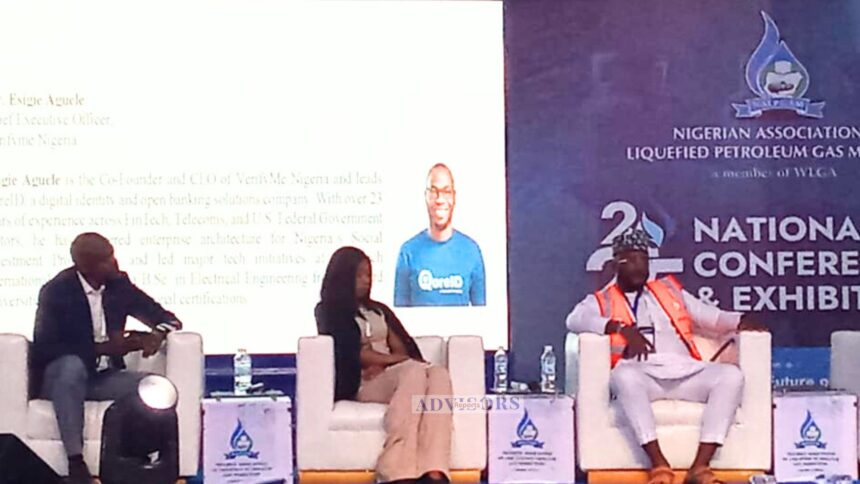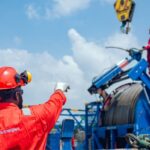Okoduwa unveils CCNA carbon credit-backed KMRV tool to drive 10m cylinders for 10m homes with smart safety features
Oredola Adeola
Experts have urged the Federal Government to expand gas utilization beyond cooking to include power and manufacturing, deploy homegrown technology, and harness carbon credits for interest-free loans.
They stressed that those steps are crucial to achieving Nigeria’s National LPG Expansion Plan target of 5 million metric tonnes per annum of domestic consumption by 2030.
The stakeholders, while speaking on the panel session themed: “Technology & Innovation in LPG: Improving Efficiency, Safety and Performance,” made the call on Thursday at the Nigerian Association of Liquefied Petroleum Gas Marketers (NALPGAM) 2025 National LPG Conference & Exhibition in Lagos.
Engineer Emeka Iheme, Managing Director of Gasavant Africa, stressed the need for urgent and deliberate action to expand Nigeria’s domestic gas consumption through innovation, efficiency, and collaboration.
Speaking during the session, he urged both public and private actors to “switch wherever possible” to LPG, not only for cooking but also for power generation and industrial use.
He emphasized that achieving the 5 million metric tonnes target requires a mindset shift.
He said, “If we stop seeing LPG as only a cooking fuel and start integrating it into industrial boilers, generators, and even logistics fleets, the transformation will follow.”
Iheme highlighted LPG’s potential beyond households, citing its role in powering industries, serving as feedstock for petrochemicals, and enabling local manufacturing.
He further explained that increased consumption would make investments in local cylinder production, skids, and related infrastructure more viable.
On safety, he stressed the integration of smart monitoring tools such as leak detectors, pressure monitors, and logistics tracking systems, said, “Safety is critical. Leak detectors, pressure monitors, and digital alerts can prevent incidents and improve trust.”
He called for stricter regulation and accreditation of installers.
Iheme also advocated collaboration with the real estate sector, urging the Federal Government to encourage developers to incorporate LPG piping systems and mini depots from the design stage.
He said, “We’re not at 100% grid power yet. That’s a fact. So, let’s start building with LPG in mind from day one.”
He added that diesel-dependent industries and facilities should be reoriented toward LPG as a cleaner, cheaper, and more efficient alternative, backed by IoT-enabled technologies for tracking and safety compliance.
According to him, the government must also prioritize producing local technologies to drive down LPG costs and make it more affordable.
“Every little opportunity is to switch to gas.
“The President should also engage real estate to instill LPG reticulation at the beginning of developments and ensure that facilities are gas-powered. Moving forward, we must prioritize gas options,” he said.
Godwin Okoduwa, Country Director, Carbon Credit Network Africa (CCNA) who was also on the panel, stated that achieving the 5 million metric tonnes domestic LPG target will require strong collaboration and innovative opportunities.
Okoduwa, who is also the LPG Committee Member of the Lagos Chamber of Commerce and Industry (LCCI), explained that the strategy includes targeting beneficiaries through structured payroll systems, where identity and credit verification would enable individuals to access interest-free loans for LPG cylinders and food.
“We are saying that individuals can get interest-free loans that can be serviced over the next 30 days without upfront payment for the cylinders,” he said.
According to him, the model will be powered by data and cylinders equipped with a technology called the Kike Monitoring, Reporting and Validation (KMRV) tool, supported by carbon financing mechanisms.
Each household, according to him, could save between 2.5 and 3 tonnes of CO₂ annually, which would then be traded in the carbon market for credit.
Okoduwa further noted that with the introduction of this technology, end-users would no longer need to pay for cylinders outright.
“They just need to click into the brain basket virtual circulation model and access the cylinder to continue the LPG consumption expansion scheme,” he added.
He explained that the system also provides opportunities for LPG marketers, who would not need to build plants in residential centers anymore, but simply set up retail kiosks and onboard cylinders through the model.
The plan, according to him, targets 10 million cylinders for 10 million homes, all equipped with monitoring and safety tools that allow users to shut down facilities in case of leakage.
“Users will also be able to order products via WhatsApp, while the system’s configuration can track consumer behavior to alert them when their cylinders are running low.
“The technology ecosystem is running on a login and tokenized network to grow the LPG market,” Okoduwa said.
He pointed out that a similar model was earlier piloted manually with Eko Gas, adding that the new approach would convince donors about the carbon savings, emission reductions, and health benefits.
The LCCI LPG Committee Member therefore emphasized that the programme would bring down LPG costs due to carbon financing, adding that the LPG adoption goes beyond monetary value.
“It would also ensure that our women are protected, and girls can go to school and stay away from hospitals,” he said.




